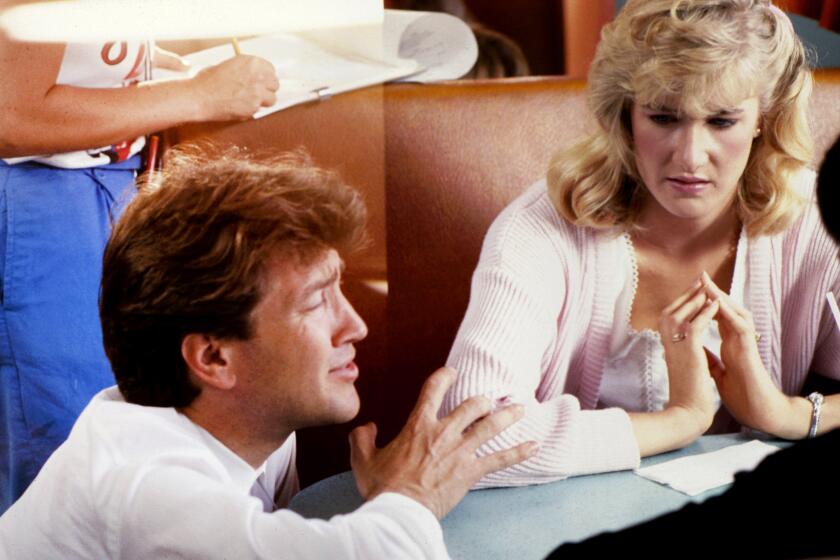Marilyn Monroe’s Image Shifts Right Along With the Times
- Share via
How would Marilyn Monroe feel about her image and legacy today? If she were alive, she’d be 75--as the endless newscasting and blitzing of the event in the media have trumpeted in recent weeks. The freakish subtext of the reporting, beyond the innocent celebration of her birthday, is that the actress who has been revered for her looks would be an old woman.
Ironically, the woman who was seen as somewhat of a joke as an actress while she was alive has eclipsed all the Hollywood legends--Clark Gable, Bette Davis, Humphrey Bogart, James Cagney, Katharine Hepburn, Mae West. For better or worse, nine out of 10 teenagers would say, ‘Bette who?’ But all 10 would know Marilyn Monroe.
Monroe would be astounded that she is more famous in 2001 than in 1962, when she died. Twentieth Century Fox shipped more than a million videocassettes of her films in North America alone to commemorate her birthday on June 1. But beyond the surface layer--the raw stardom--what would gratify Monroe most is the respect. Time has adjusted the fuzzy focus that couldn’t see beyond the sexism, prejudice and ignorance of the 1950s and 1960s. Monroe is finally being taken seriously, on many levels.
Echoing the critical community, Richard Pena, head of the New York Film Festival at Lincoln Center, compares Monroe’s cinematic artistry to the deftness of Josephine Baker.
“She was way ahead of her time in the way that she was not only constructing an image but playing with it, making it sometimes so much larger than life that it becomes almost a parody of womanhood,” Pena says. “In the same way, Josephine Baker would sometimes play up her exoticism as a black woman, putting herself in cages and wearing bananas, you see how she [Monroe] was playing with that exact exoticism, the American screen goddess.”
Time and perspective have clarified her artistic legacy. Once categorized as the frothy-blond successor to Alice Faye and Betty Grable, Monroe’s brilliance and uniqueness are more apparent, especially her comedy work, which was the most overlooked. Pena calls it “the extraordinary sense of detail in her performance. It’s remarkable. That’s why her films repay re-viewing. Her gestures, her stances, her looks. There is never a sense of her on top of the film. She is always into it.”
Monroe has been an ever-shifting Rorschach to America for 50 years. “I think it is difficult to find anyone who has been embraced by more members of the media from various political spectrums and social viewpoints and embraced her as their own, whether it’s a feminist like Gloria Steinem or Norman Mailer,” says Playboy founder Hugh Hefner. “Each one, in an inkblot way, projects their own dreams and fantasies and vulnerabilities and desires onto her.”
But the dubious adjunct to the iconography as Ultimate Screen Goddess is that Monroe has become a cottage industry. Marilyn Monroe the commodity--which is how she was so often treated in life--is now a full-blown industry: millions of images duplicated, millions of words written in books and magazines, hundreds of Web sites devoted to her, her belongings and clothing sold or auctioned for hundreds of thousands of dollars. A reputable Midwest dealer is currently selling her engraved compact for $2,850, rhinestone 1950s sunglasses for $6,500 and a 1940s bathing suit for $3,400.
But she might take comfort that even as her image is hawked like a box of detergent, the tone has shifted. A decade ago, the best-selling stand-up full-size cutouts were cheesecake shots of her in a skimpy bathing suit or the upward-billowing skirt of “The Seven Year Itch.” But those are now outsold by a refined Monroe-- in non-cleavage, stately shots, like a sedate pose in the red dress from “Niagara.”
“People want to see Marilyn as classy,” says Steve Henderson, who owns Advanced Graphics, which ships 1,000 Monroe cutouts a month. And the sheer level of her continued fame, unprecedented for a movie star, astonishes everyone, including the ardent fans. “I keep holding my breath waiting for the next generation to say, ‘Who’s Marilyn Monroe?’ ” says collector and Monroe expert Richard Wilson, “like a lot of people today say, ‘Who is Jean Harlow?’ ”
Marilyn Monroe is very much in the present tense, like Elvis Presley. Both have been canonized. But where Presley has guardians like Priscilla Presley to ensure the image, legacy and licensing, Monroe’s estate is controlled by a woman she never knew. Anna Strasberg gained control as the second wife of Lee Strasberg, Monroe’s acting coach and friend and sole heir of her estate, after both their deaths.
Anna Strasberg checks Monroe’s licensed images for political correctness. Monroe was known, even back in the late ‘50s, as an ardent animal lover. (Her ex-husband Arthur Miller used Monroe’s concern for animals in his screenplay for “The Misfits.”). Strasberg vetoes all images in which Marilyn wears fur--which was often. And a rare photograph of Monroe lying on a settee and covered in feathers had to be air-brushed to appear as if she was covered by a satin sheet. “As a Hollywood historian, I have an objection to any kind of political rewriting of history, even political correctness,” says Monroe expert Jack Allen, author of “Marilyn by Moonlight.”
Adds Allen: “It’s absurd to go back and censor photographs. It was the mode of the day 60 years ago for stylish women to wear fur when they went out.”
Anna Strasberg refused to comment for this story beyond saying, “I don’t talk about Marilyn. Too many words have been written about her.”
*
Avalanche Publishing, a calendar company planning a 1999 tribute calendar featuring rare photographs and accompanying biographical text, received this warning from CMG, the licensing agency hired by Strasberg: “The Estate will not approve any references to Marilyn’s marriages, divorces, physical problems, her alleged chemical dependencies or her death within the text of the calendar.”
“I thought they were fighting a losing battle. Her story is pretty common knowledge and to try to go back and rewrite history doesn’t seem right,” remembers Avalanche’s former president, Cathy Hull. “It got to the point where we just stopped writing text. We just had to pretend she had a wonderful life.” (Calls to CMG for this story were not returned).
Greg Scheiner, president of the Los Angeles-based fan club, Marilyn Remembered, believes Monroe would be outraged at what has happened. “The whole concept of this kind of licensing didn’t exist in her time. There was no such thing at that time, to license a dead movie star. She would have had no way to foresee in her will that aspect of her life being utilized.”
And the story of her life is continually tampered with by new claims of those who knew her, wed her, bedded her. “If everyone who claims to have spoken to her the night she died had actually spoken to her, she would have needed a switchboard operator,” quips Allen ruefully . “Everybody wants to ride the coattails of the No. 1 star of the century.”
Marilyn Remembered monitors Monroe’s history. Like an academic historical society, the club sorts out those who have a genuine claim of knowing Monroe from those whose assertions are dubious.
“There have been a great deal of inaccuracies in print over the years, and we’ve tried to sort out the truth from the fiction, to nail down what really happened, as best as we can,” says Scheiner, who lists Maurice Zolotow, Fred Lawrence Guiles and Donald Spoto as among the best, and most authoritative, biographers of Monroe.
Monroe obsessed about her appearance, but it was her art that counted. And the almost-archeological unveiling this month of Monroe’s controversial last performance in “Something’s Got to Give” would give her some vindication and pleasure (the DVD of the film was just released). Like court documents that have been unsealed, the record can finally be straightened. The studio said she, not the film, was the problem, and she was fired. But, in fact, the film is worse than imagined--a cheesy early ‘60s, badly cast, unfunny, dated sex comedy.
“‘Marilyn had issues with the script, which may have been justified,” says Kevin Burns, who produced “Marilyn Monroe: The Final Days,” the documentary for American Movie Classics and 20th Century Fox that includes the reconstructed footage. And however fragile or emotionally unbalanced she was, she also reaches new highs as an artist and in her quest for self-actualization. It is her first performance without a mask, the first to clearly drop the Marilyn persona. The little-girl voice is, at moments, gone.
“‘It’s a glimpse of what might have been,” Burns says.
At her death, in 1962, Monroe was the pitiable victim of the big, bad studio machine--another Frances Farmer. Post-assassination and Watergate America focused on the conspiracy of her death and espoused government cover-up. As liberation--gay, woman, African American--took hold in the 1970s, the pioneer elements of her biography started to take hold: the woman who fought her studio and went to New York to study with the Actors Studio, the determination to hold onto her identity and career with husband Joe DiMaggio, the temerity to form her own production company and hire Laurence Olivier as co-star in “The Prince and the Showgirl.”
*
The New York Film Festival’s Pena points to the scene in “Something’s Got to Give” when she returns home and sees her children after several years of absence. “You feel a moment of abandon, she’s wrestling with the boy, hugging him, playful, then all of a sudden she draws back, pulls her hair away. There’s this sense, a signal, that we know that more is going on, that this is a mother coming back rather than a nice lady. They signal the magic of Monroe, as a performer she builds this extraordinary connection with the audience.”
Monroe knew she was underestimated--she underestimated herself, but she always defied reality and expectation. Born into poverty and dysfunction, she became one of the world’s highest paid and most famous women. Starting her career as a pinup in a nudie calendar--meant for garage walls and locker rooms--she ended up in Buckingham Palace, curtsying for the queen. Typecast relentlessly as a dumb, stacked blond, she willed herself and the industry to take her seriously as an actress.
“We know so much more now than we knew during her lifetime--about childhood abuse and how to treat it, drug and alcohol dependency, the bipolar personality, co-dependency and everything else that plagued her,” says author and lecturer Marianne Williamson. “Add to that America’s profound ambivalence toward women of extraordinary beauty, intelligence or talent--much less a woman who was blessed with all three--and I suppose that she was, in a way, doomed. But I envision a world where . . . she would both know how to live well and the rest of us would know how to truly embrace her.”
More to Read
Only good movies
Get the Indie Focus newsletter, Mark Olsen's weekly guide to the world of cinema.
You may occasionally receive promotional content from the Los Angeles Times.










